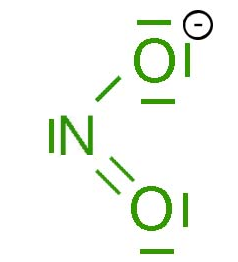







Search:

With the exception of Experiment 1, use a dilute solution of $KNO_2$
|
1. $H_2SO_4$ (eventually warm) |
Dismutation: $3NO_2^-+2H^+$ $\longrightarrow$ $NO_3^-+2NO+H_2O$ - in the air $NO$is oxidised to $NO_2$, a red gas! |
|
2. $MnO_4^-$ (Potassium permanganate in acid medium) |
|
Oxidation ($NO_2^-$ reductant): $NO_2^-$ $+$ $H_2O$ $-$ $2e^-$ $\longrightarrow$ $NO_3^-$ $+$ $2H^+$/$E_o=0,94V$ $5NO_2^-$ $+$ $2MnO_4^-$ $+$ $6H^+$ $\longrightarrow$ $5NO_3^-$ $+$ $2Mn^{2+}$ $+$ $3H_2O$ |
|
3. $I^-$ (Potassium iodide in an acidic medium) |
|
Reduction ($NO_2^-$ oxidising agent): $NO_2^-$ $+$ $2H^+$ $+$ $e^-$ $\longrightarrow$ $NO$ $+$ $H_2O$/$E_o=0,99V$ $2NO_2^-$ $+$ $4H^+$ $+$ $2I^-$ $\longrightarrow$ $2NO$ $+$ $2H_2O+I_2$ |
|
4. Diphenylamine in the presence of conc. $H_2SO_4$ |
|
Navy blue color (Wet the inside a test tube with the reactant, thereafter introduce a few drops of nitrite) This reaction is very sensitive, but not specific; nitrates and chlorates do the same. |
|
5. Diazotation (Griess reaction) |
|
(Operate with traces of nitrate! Mix in a test tube: 1-2 mL of an acetic solution of sulfanilic acid with 1-2 mL of an acetic solution of α naphthylamine. sAdd one drop of the diluted solution of nitrite. There is formation of a cherry-red compound. ) - Very sensitive reaction - Specific reaction |